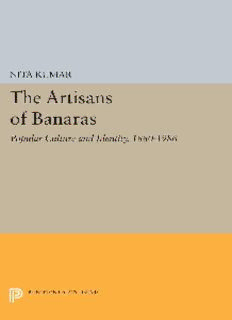
The Artisans of Banaras: Popular Culture and Identity, 1880-1986 PDF
Preview The Artisans of Banaras: Popular Culture and Identity, 1880-1986
The Artisans of Banaras THE Artisans of Banaras Popular Culture and Identity, 1880-1986 NITA KUMAR PRINCETON UNIVERSITY PRESS Princeton, New Jersey Copyright © 1988 by Princeton University Press Published by Princeton University Press, 41 William Street, Princeton, New Jersey 08540 In the United Kingdom: Princeton University Press, Guildford, Surrey All rights Reserved This book has been composed in Linotron 202 BaskerviUe and Zapf International Clothbound editions of Princeton University Press books are printed on acid-free paper, and binding materials are chosen for strength and durability. Paperbacks, although satisfactory for personal collections, are not usually suitable for library rebinding Printed in the United States of America by Princeton University Press, Princeton, New Jersey Publication of this book has been aided by a grant from the Publications Program of the National Endowment for the Humanities, an independent federal agency Kumar, Nita, 1951- The artisans of Banaras. Bibliography: p. 1. Varanasi (India)—Social life and customs. 2. Artisans—India—Varanasi—Recreation. I. Title. DS486.B4K86 1988 3o6'4'o9542 88-15176 ISBN 0-691-0553 i-g To my parents for a wonderful childhood world and to Shankar and Tara Prasad for glimpses of a different world Contents List of Figures ix List of Tables xi Preface xiii Note on Translation xvii Abbreviations xix Introduction 3 Popular Culture 4 History and Anthropology 5 On Identity, and Other Conclusions 7 The Chapters and Their Argument g 1. The Artisans of Banaras 12 The Nature of Work 13 Weavers 14 Metalworkers 25 Woodworkers 33 2. The Question of Identity 40 The Relations of Production 40 The Rhythms of Work 46 The Identity of an Ansari 49 The Identity of a Kasera 57 The Identity of a Woodworker 60 VlI VlIl CONTENTS 3. The Banaras of the Artisans 63 The Artisans' Mohallas 65 The Nature of Banarasipan 72 4. The Outer Side 83 Bahri Alang as Space 85 Bahri Alang as Time 91 Bahri Alang as Ritual 97 Bahri Alang as Mood 99 Bahri Alang for Muslims 100 The Decline of an Ideal 105 5. The Body and Its Pleasures 111 The Akhara 111 Akhara Ritual and Philosophy 113 The Social Organization of the Akhara 116 The Process of Decline 119 6. The Artisans' World of Music 125 Melas 125 The Burhva Mangal 126 The Monsoon Melas 131 Mandirs and Mazars 140 Musical Styles 147 Mehfils 154 7. Cutting Off the Nose, and Other Obscenities 165 The Four Major Festivals 165 The Nakkatayya of Chaitganj 180 Bharat Milap and Nag Nathayya 197 8. More on the Question of Identity 201 Caste and Class 201 Hindu-Muslim Relations 211 Conclusion 229 Appendix A: Sources and Research Methodology 237 The Limits of Ethnosociology 243 Appendix B: Tara Prasad's Bhang Recipe 244 Glossary 245 Bibliography 253 Index 271 List of Figures i. Banaras: Population Growth in Comparison with Other Cities 64 2. Banaras: Wards and Population Density 66 3. Banaras: Location of Main Artisan Communities 67 4. Banaras: Location of Cultural Activities 86 5. The Hindu Calendar in Banaras 126 6. The Muslim Calendar in Banaras 138 IX
Description: